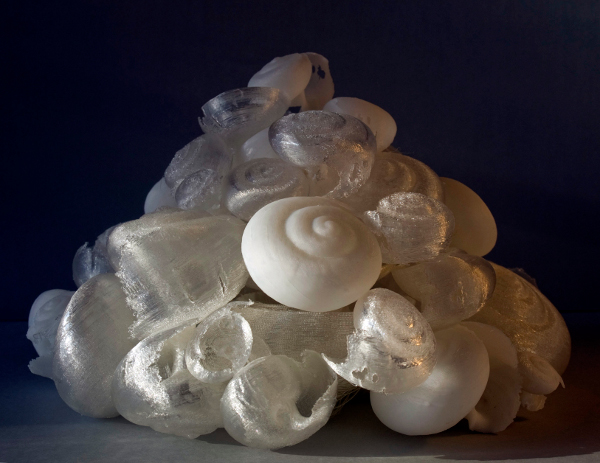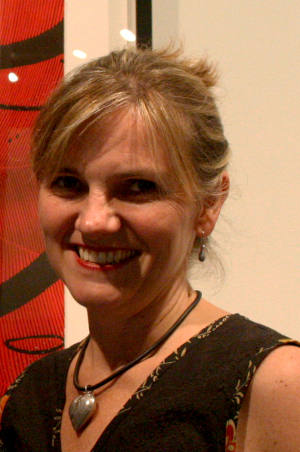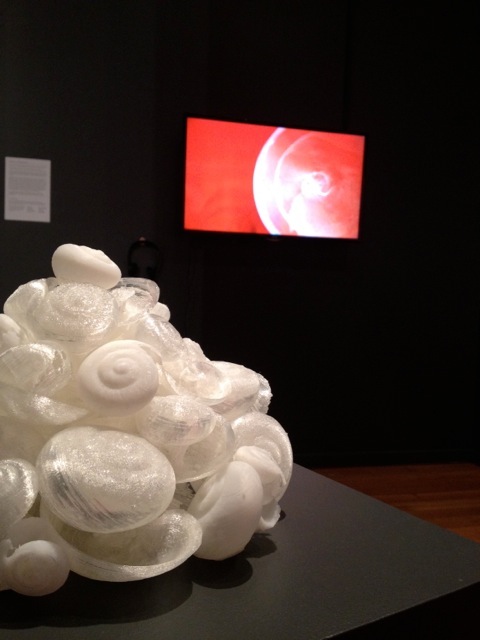Living Data
Science Art & Talks
The experiential process of observation and reflection is key to art and science
and is an essential component in understanding interdependence
of all species and ecosystems, terrestrial and aquatic.
Paul Fletcher Animator
Science Art & Talks
Living Data Program for the 2013 Ultimo Science Festival, Sydney, September 12-21.
Dissolve II, 2013 Objects and animation by Melissa Smith with Tim Senden and Hannah Wolfhagen
Ocean acidification is threatening the pteropod (sea butterfly) which sustains many key marine creatures.
Metaphors are used in art to relate mysteries of the Ocean to familiar terrestrial forms.

Midden 2013
3D print by Melissa Smith
30cm W x 30cm D x 20 cm H
The image is integral to articulating understandings gleaned from observation and analysis.
Shell middens have an association with a number of cultural groups throughout history including the Australian aboriginals. This work is not making a reference to a particular cultural activity but identifying the pteropod as a food source in a chain of survival and life. The sea butterfly as a single shell appears a small thing, but when many shells form a pyramid of the sea, there is a sense of abundance, although their hollow nature suggests otherwise.
The pteropod, commonly known as the sea butterfly, is a species indicative of the ecosystem health of the Southern Ocean. I first knew about sea butterflies from reading the paper, Krill looks and feelers: a dialogue on changing perceptions of climate change data (Roberts & Nicol, 2011). My current work contributes an empathic response to what are otherwise mostly scientific descriptions, through metaphors which relate mysteries of the ocean to familiar terrestrial forms, such as the midden (above).
For many years my prints have referenced aspects of the landscape and more recently the shifts within it occurring from disturbances to natural climatic change cycles. By utilising traditional and new technologies I invite people to engage with the plight of the pteropod on many levels, from interactive QR code prints which link to websites about threats to its existence, to data that plot graphs of increasing sea temperature, C02 intake and acidity levels.
Dispel, 2013 An X-Ray microCT scan of a shelled pteropod - Limacina helicina antarctica (sea butterfly)- is animated by a scientist, inspires the creative direction of a visual artist and a music score by an emerging composer. Slowly the shell falls into view and rotates to reveal its beautiful, delicate form. Just as we feel we could touch its fragile surface, it cascades away, the illusion dispelled.
Dispel 2013
digital animation, 2min 30sec
Animator: Professor Tim Senden
Music: Thecosomata
Composer - Hannah Wolfhagen
Viola - Hannah Wolfhagen Piano - Michelle Els
Creative Direction: Melissa Smith

Melissa Smith. Photo: Jennifer Dickens
I am currently working in two roles with Arts Tasmania, that of Roving Curator with Small Museums and Collections statewide and Program Officer for Public Art in the North/Northwest of Tasmania. Previous to these positions I was an Art educator in a senior role at Scotch Oakburn College in Launceston for 27 years. My artistic practice has run concurrently with these roles for the last seventeen years, in many cases one inspiring the other. I have participated in solo and numerous group exhibitions throughout Australia and overseas. In 2004 and 2006 I won the Tasmanian Art Award and have been a finalist in a number of major art prizes including the Fremantle Print Award and Silkcut Print Award in which both my work has been acquired. My work has also been represented in the Alice Prize, Hutchins Art Prize, Burnie Print Prize, Rena Ellen Jones Memorial Print Award, Sunshine Coast Art Prize, Banyule Works on Paper Art Award and the Outback Prize. In 2005 and 2011 I was selected by the Print Council of Australia to produce a commissioned Member's print. My work is represented in Corporate, Tertiary, College and Private collections in Australia and overseas, and in the following Public galleries: National Gallery of Australia, ACT; Burnie Regional Gallery, Queen Victoria Museum and Art Gallery, TAS; Wagga Wagga Art Gallery, Grafton Regional Gallery, Tweed River Regional Art Gallery, NSW and the Warrnambool Art Gallery, VIC.
Notes for exhibition designers:
Displaying the animation and object in close proximity allows for people to make connections between them, offering two ways of engaging with the scientific knowledge of pteropod shells dissolving. The photo below shows how the Dissolve II exhibits were installed at the Devonport Regional Gallery earlier in 2013. The animation was played on a plasma screen with headphones attached. The Midden was arranged on a nearby plinth and lit from above. The Muse will be dimly lit to suggest the depth and mystery of the ocean. Overhead lighting would disrupt this sense and so a small light beneath the Midden will be needed. Lighting from beneath will illuminate the transluscent forms of the shells, adding further to the sense of mystery. The work is extremely fragile and must be placed where it can be seen but not touched.

Midden, 3D print, 30cm W x 30cm D x 20 cm H
Dispel. Digital animation, 2min 30sec











